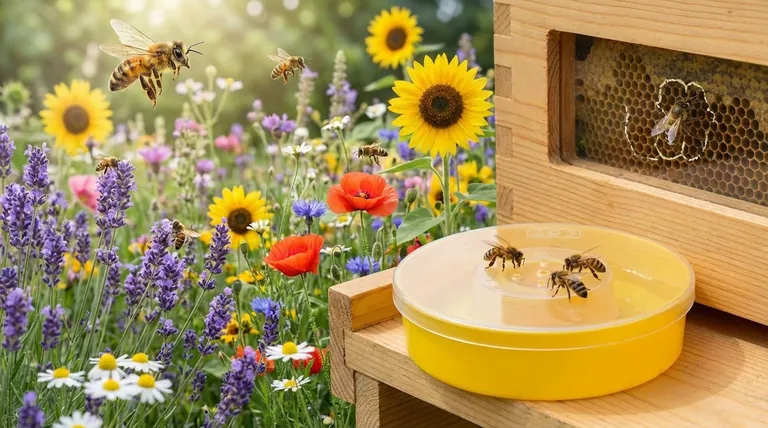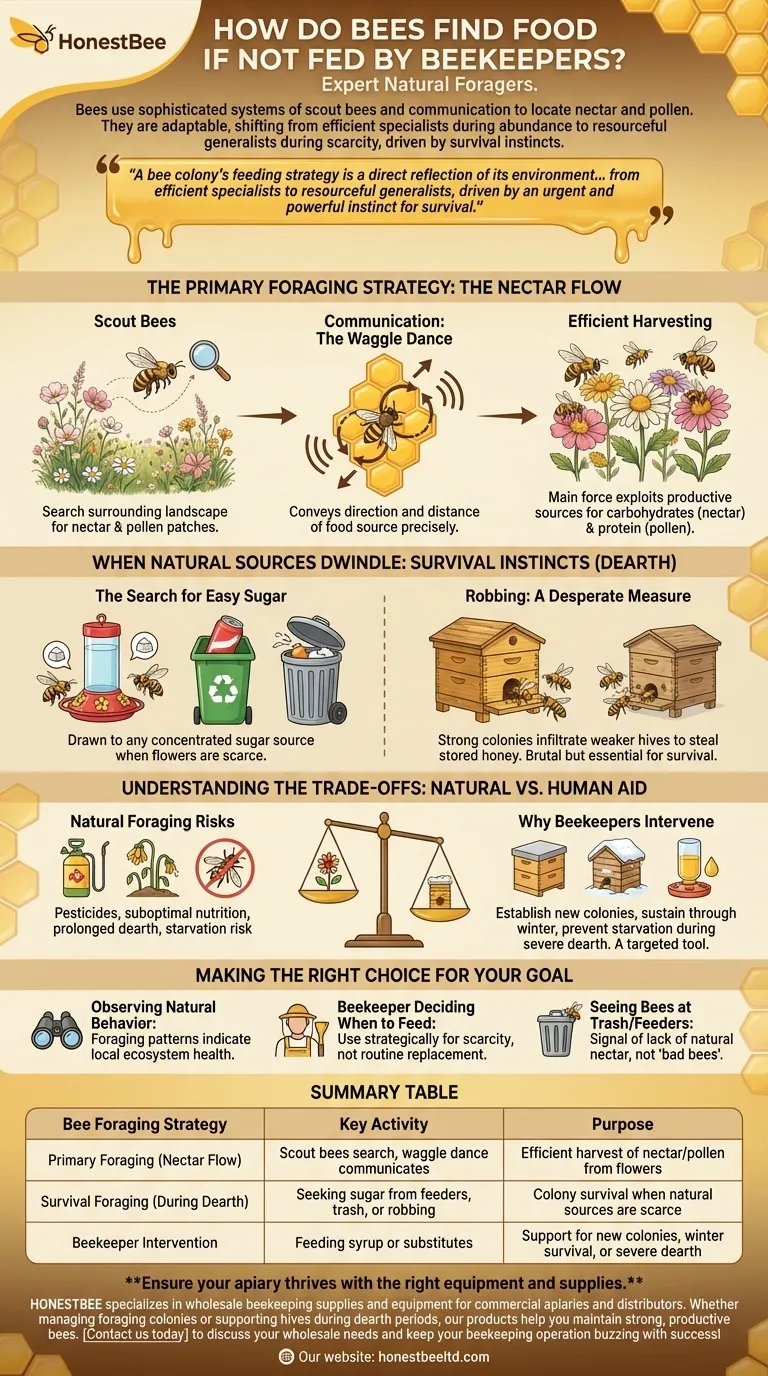In short, bees are expert natural foragers. When not fed by a beekeeper, a honey bee colony uses a highly sophisticated system of scout bees and communication to locate and harvest nectar and pollen from flowering plants. During periods of scarcity, their survival instincts drive them to seek out any available sugar source, from hummingbird feeders to discarded soda cans.
A bee colony's feeding strategy is a direct reflection of its environment. In times of abundance, they are efficient specialists focused on flowers, but in times of scarcity, they become resourceful generalists, driven by an urgent and powerful instinct for survival.

The Primary Foraging Strategy: The Nectar Flow
A healthy, established colony's preferred method for gathering food is to tap into the natural cycle of flowering plants, known as a nectar flow. This is a period when there is abundant nectar available for collection.
The Role of Scout Bees
A small percentage of a colony's foragers act as scouts. Their sole job is to fly out and search the surrounding landscape for promising patches of flowers rich in nectar and pollen.
Communication: The Waggle Dance
When a scout bee finds a valuable food source, she returns to the hive and performs a remarkable communication pattern known as the "waggle dance." This dance conveys the direction and distance of the food source to her sister foragers with incredible precision.
Efficient Harvesting
Once the waggle dance has communicated the location, the main force of forager bees flies directly to the source to begin harvesting. They will continue to exploit this source as long as it remains productive, ensuring the colony has a steady income of carbohydrates (nectar) and protein (pollen).
When Natural Sources Dwindle: Survival Instincts
When a nectar flow ends or is unavailable (a period called a "dearth"), the colony's behavior shifts from efficient harvesting to opportunistic survival.
The Search for Easy Sugar
Bees are drawn to any concentrated sugar source. During a dearth, they become highly resourceful, and you may find them in unusual places.
These include hummingbird feeders, open garbage cans, and recycling bins containing residue from soda cans. They are not being picky; they are simply following the scent of sugar to find life-sustaining calories.
Robbing: A Desperate Measure
One of the most dramatic survival behaviors is robbing. Stronger, more populous colonies may identify weaker neighboring hives and attempt to infiltrate them to steal their stored honey.
This is a brutal and often fatal activity for the bees involved, but it highlights the powerful drive to ensure the colony's survival at all costs.
Understanding the Trade-offs: Natural Foraging vs. Human Aid
The practice of beekeepers feeding bees exists to manage the risks and challenges inherent in a bee's natural life.
The Risks of Natural Foraging
While foraging is their natural state, it is not without risk. Bees may encounter pesticides on crops or collect nectar from plants that provide suboptimal nutrition. A prolonged dearth with no alternative sources can lead to starvation.
Why Beekeepers Intervene
Beekeepers feed sugar syrup or pollen substitutes for specific reasons. This is done to help a new colony get established, to sustain a hive through the winter when no flowers are blooming, or to prevent starvation during a severe nectar dearth. It is a targeted tool, not a replacement for natural foraging.
Making the Right Choice for Your Goal
Understanding how bees find food helps you interpret their behavior and make better decisions, whether you are a beekeeper or an observer.
- If your primary focus is observing natural bee behavior: Recognize that their foraging patterns are a direct indicator of the health of their local ecosystem.
- If you are a beekeeper deciding when to feed: Use feeding strategically to support your hive's survival during documented periods of scarcity, not as a routine replacement for their own efforts.
- If you see bees at your trash can or hummingbird feeder: This is not a sign of "bad bees," but a clear signal that there is a lack of natural nectar sources in your area.
Ultimately, a honey bee colony is a resilient and adaptable superorganism, capable of sustaining itself through both bounty and scarcity.
Summary Table:
| Bee Foraging Strategy | Key Activity | Purpose |
|---|---|---|
| Primary Foraging (Nectar Flow) | Scout bees search, waggle dance communicates | Efficient harvest of nectar/pollen from flowers |
| Survival Foraging (During Dearth) | Seeking sugar from feeders, trash, or robbing other hives | Colony survival when natural sources are scarce |
| Beekeeper Intervention | Feeding syrup or substitutes | Support for new colonies, winter survival, or severe dearth |
Ensure your apiary thrives with the right equipment and supplies. HONESTBEE specializes in wholesale beekeeping supplies and equipment for commercial apiaries and distributors. Whether you're managing foraging colonies or supporting hives during dearth periods, our products help you maintain strong, productive bees. Contact us today to discuss your wholesale needs and keep your beekeeping operation buzzing with success!
Visual Guide

Related Products
- HONESTBEE Round Hive Top Bee Feeder for Syrup
- Rapid Bee Feeder White Plastic 2L Round Top Feeder for 8 or 10-Frame Bee Hives
- Classic Boardman Entrance Bee Feeder Hive Front Feeding Solution
- Professional Hive Top Bee Feeder for Beekeeping
- HONESTBEE Entrance Bee Feeder Professional Hive Nutrition Solution for Beekeeping
People Also Ask
- What are the features of top feeders for bees? Maximize Hive Health with Safe, High-Capacity Feeding
- Why is a top feeder essential for bees? Ensure Colony Health and Efficiency
- What can the round hive top feeder be used for? A Guide to Efficient, Safe Bee Feeding
- How do you set up and use a top feeder for bees? A Step-by-Step Guide for Safe Feeding
- What is the correct method for preparing sugar syrup for bees? Ensure Safe, Non-Toxic Feeding for Your Hives



















